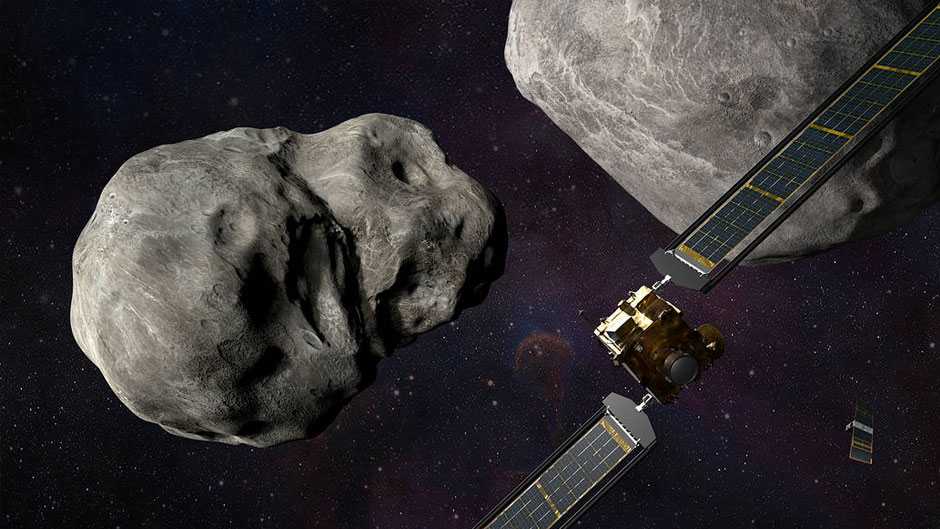Measuring 1.1 miles in diameter, it is four times the size of the Empire State Building and as large as Plum Island off the coast of New York. On Friday, May 27, it will make its approach toward Earth, traveling 20 times faster than a speeding bullet.
No need to panic, however. Asteroid 7335, as it is officially called, will safely pass our planet, missing Earth by about 2.5 million miles, astronomers say.
Still, it is one of a small number of near-Earth objects, or NEOs, that NASA has labeled as “potentially hazardous.” Such objects are defined as asteroids that measure at least 460 feet across and come within 4.6 million miles of Earth’s orbit around the Sun.
NASA continuously monitors NEOs like Asteroid 7335, assessing any impact risk they may pose. The space agency has even launched a program, Double Asteroid Redirection Test (DART), to alter an asteroid’s path. A NASA spacecraft is set for a head-on collision with the 525-foot Dimorphos in fall 2022.
“The goal of DART is both technology development and observation, specifically testing and observing a method of asteroid deflection in the event that we ever discover an asteroid that threatens Earth,” said Lynn Sargent, a research assistant and Ph.D. candidate studying aerospace and mechanical engineering in the University of Miami’s College of Engineering.
“The [NASA] satellite will be completely destroyed in this mission, but it’s my understanding they plan to keep intact [a miniaturized satellite called] a CubeSat to record data that will be deployed a short time prior to the impact,” she explained.
Sargent and a multitude of other scientists will be keeping an eye on Asteroid 7335, satisfying their scientific curiosity in the process. The giant rock will not make another close flyby of Earth until 2055. Until that time, other asteroids will undoubtedly zoom past Earth.
Just how are they discovered? That’s the job of NASA’s Near-Earth Object Observations Program, an initiative that uses telescopes around the world to search for NEOs; track them to determine their orbits; and gather data on their sizes, shapes, and composition.
Hunting for asteroids, however, is not solely the job of NASA scientists. “Detecting and observing asteroids is done by amateur astronomers all the time,” said Josh Gundersen, a professor of physics in the University of Miami’s College of Arts and Sciences, whose research interests range from our own galaxy, the Milky Way, to the cosmos and the Big Bang.
“While Asteroid 7335 was first detected by a professional astronomer using a very large telescope, in general this doesn’t have to be the case. Someone with a standard eight-inch telescope equipped with a CCD camera observing from a decent site like the Everglades can observe a large number of asteroids,” he explained.
Alessandro Peca, a Ph.D. student studying physics and astronomy, answers some questions about asteroids, from their origins to how they differ from comets and meteors.
What are asteroids, and where do they come from?
Asteroids are big, rocky, metallic objects that orbit the sun. They’re too small to be considered planets, but they’re sometimes called minor planets. They are leftovers, remnants from the formation of our solar system. About 4.6 billion years ago, our solar system was made of gas and dust. When the sun originated in the middle of this dust, planets started forming around it by accumulating gas and dust around the sun. Asteroids are leftovers of this process.
What’s the difference between asteroids, comets, and meteors?
The difference between meteoroids and asteroids is the size. Objects smaller than one meter are meteoroids—meteor is an old term—while bigger objects are called asteroids. A comet is a rocky object as well, but it usually shows a bright tail, which is due to the sublimation of ice on the comet’s surface.
Asteroid 7335, which is about 1.1 miles in diameter, will miss Earth by nearly 2.5 million miles, which is about 10 times the average distance between Earth and the moon. As such, why is it considered a near-Earth object that is “potentially hazardous?”
Astronomical distances are not something we have to deal with every day. For example, the size of our solar system is about 100,000 times the distance from the Sun to the Earth. Therefore, it is easy to understand that the 2.5 million miles by which Asteroid 7335 will miss our planet is a small distance. But it’s important to understand that when scientists classify an asteroid as “potentially hazardous,” it just means that it is better to monitor it.
Asteroid 7335 is traveling at about 47,200 miles per hour, or 20 times faster than a speeding bullet. How does it achieve such incredible velocity?
The gas, dust, light, and microscopic particles in outer space exist in concentrations that are too low to have much of an effect on objects in space. So, there is basically no friction in space to slow down moving objects. And, as a result, it is normal to have objects moving at extremely high rates of velocity. For example, the Earth’s orbital speed around the sun is about 67,000 miles per hour. If an object like Asteroid 7335 were to hit Earth, the consequences would be problematic. But again, the chances of this happening are very low.

